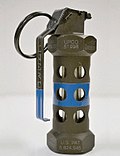This article needs additional citations for verification .(March 2013) |
This is a list of weapons served individually by the United States armed forces. While the general understanding is that crew-served weapons require more than one person to operate them, there are important exceptions in the case for both squad automatic weapons (SAW) and sniper rifles. Within the Table of Organization and Equipment for both the United States Army and the United States Marine Corps, these two classes of weapons are considered as crew-served; the operator of the weapon has an assistant who carries additional ammunition and associated equipment, acts as a spotter, and is also fully qualified in the operation of the weapon. These weapons are listed under the List of crew-served weapons of the U.S. armed forces.
Contents
- Bayonets, knives, and bayonet-knife models
- In active service (some branches or limited roles)
- Out of service (obsolete)
- Grenades
- In active service
- In active service (some branches or limited roles) 2
- Out of service (obsolete) 2
- Sidearms
- In active service 2
- In active service (some branches or limited roles) 3
- Out of service (obsolete) 3
- Canceled experiments and competitions
- Less-lethal
- In active service (some branches or limited roles) 4
- Out of service (obsolete) 4
- Rifles
- In active service (some branches or limited roles) 5
- Out of service (obsolete) 5
- Experimental
- Canceled experiments
- Carbines
- In active service 3
- In active service (some branches or limited roles) 6
- Out of service (obsolete) 6
- Canceled experiments and competitions 2
- Shotguns
- In active service 4
- In active service (some branches or limited roles) 7
- Out of service/Canceled
- Experimental 2
- Submachine guns
- In active service (some branches or limited roles) 8
- Out of service (obsolete) 7
- Swords
- In active service 5
- Out of service
- See also
- References


























